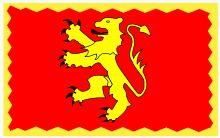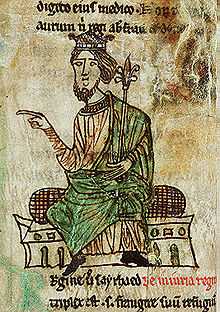Nest ferch Rhys
Nest ferch Rhys (c. 1085 - before 1136) was the only legitimate daughter of Rhys ap Tewdwr, last King of Deheubarth, by his wife, Gwladys ferch Rhiwallon ap Cynfyn of Powys. She is sometimes known, incorrectly, as "Nesta" or "Princess Nesta".[1][2]
Nest had two younger brothers, Gruffydd ap Rhys and Hywel, and, possibly, an older sister named Marared, as well as several older illegitimate half-brothers and half-sisters. After their father's death in battle in 1093, "the kingdom of the Britons fell" and was overrun by Normans. Nest's younger brother Gruffydd was spirited into Ireland for safety; their brother Hywel may have been captured by Arnulf de Montgomery, along with their mother, unless, as appears likelier, their mother was captured with Nest; their fate is unknown. Two older brothers, illegitimate sons of Rhys, one of them named Goronwy, were captured and executed.

First marriage and issue
After Nest reached puberty, she came to the attention of the youngest son of William the Conqueror, Henry I of England, to whom she bore one of his numerous illegitimate children, Henry FitzHenry (c. 1103–1158).[3]
Some time after the rebellions of Robert of Normandy and Robert of Belesme, head of the powerful Montgomery family of Normandy and England, the king married Nest to Gerald FitzWalter of Windsor, Arnulf de Montgomery's former lieutenant and constable for Pembroke Castle. In 1102, for siding with the Montgomerys against the king, Gerald had been removed from control of Pembroke, and one Saher, a knight loyal to Henry, installed in his place. When Saher proved untenable in his new position, the king restored Gerald to Pembroke in 1105, along with Nest as his wife.[4] By Gerald, Nest is the maternal progenitor of the FitzGerald dynasty, one of the most celebrated families of Ireland and Great Britain. They are referred to as Cambro-Normans or Hiberno-Normans, and have been Peers of Ireland since 1316, when Edward II created the earldom of Kildare for John FitzGerald.
Nest bore Gerald at least five children, three sons and two daughters. Through her children by Gerald, Nest is an ancestress of the de Bohun Family, the Tudor monarchs of England, and, through the Tudors, of the Stuarts, as well as of President John F. Kennedy, and Diana, Princess of Wales.
- William FitzGerald, Lord of Carew and Emlyn (d. c.1173). By his marriage to Marie, a daughter of Arnulf de Montgomery [see Note following Maurice FitzGerald below], William was the father of:
- Odo de Carew
- Raymond FitzGerald le Gros
- Griffin
- Richard
- Ralph
- William, Justice of Eyre
- Robert
- Isabella; m. William Hay (Gulielmus de Haia Wallenisis).
Note: William Hay is frequently, and incorrectly, noted as an illegitimate son of Nest; the speculation is based on Nest's grandson, Gerald of Wales, naming William as a Geraldine, which William Hay was, by his marriage to Nest's granddaughter. William's father is erroneously given as one "Hayt", a Flemish sheriff of Pembroke in 1130, by which time Nest would probably have been past childbearing age. Most likely William was the son of Robert de la Hay, who held Gwynllŵg as a fief from Robert fitz Hamo, earl of Gloucester.[5]
- Maurice FitzGerald, Lord of Lanstephan, Naas and Maynooth, (died 1 September 1177). By his marriage to Alice [see Note below], a daughter of Arnulf de Montgomery, Maurice was the father of:
- Gerald FitzMaurice, 1st Lord of Offaly
- Alexander
- William (1st Baron Naas)
- Maurice of Kiltrany
- Thomas
- Robert
- Nest
Note: The existence of Marie de Montgomery and Alice de Montgomery, along with that of their alleged half-brother Philip, is disputed by one Kathleen Thompson, Honorary Reader in history from Sheffield University, who claims Arnulf died without issue.
- David FitzGerald, Archdeacon of Cardigan and Bishop of St David's who was the father of:
- Milo FitzBishop of Iverk
- Angharad, who married (2) William Fitz Odo de Barry, by whom she was the mother of
- Philip de Barry, founder of Ballybeg Abbey at Buttevant in Ireland
- Robert de Barry
- Edmond de Barry
- Gerald de Barry, (better known as Gerald of Wales or Latinised as Giraldus Cambrensis)
- Gwladys, mother of
- Milo de Cogan
Second marriage and issue
After Gerald's death, Nest's sons married her to Stephen, her husband's constable of Cardigan, by whom she had another son, possibly two; the eldest was Robert Fitz-Stephen (d. 1182), one of the Norman conquerors of Ireland; the second son, if such there were, may have been named Hywel. Some sources say that Robert was a bastard. This is unlikely to be the case as Robert's heirs were the Carew (Carey) family, the representatives of his eldest half-brother, William de Carew. According to Rev. Barry, they "...should not have gone to them, but to the Crown, if Robert FitzStephen were illegitimate".[6] With Nest's son Maurice FitzGerald, his half-brother, Robert laid siege to the town of Wexford in 1169. With Maurice, he was granted joint custody of the town.
Rape and abduction
The details of this most famous episode of Nest's life are obscure and vary, depending on who is relating it. Either Nest and Gerald were present at an eisteddfod given, during a truce, by Cadwgan ap Bleddyn, prince of Powys; or they were not present, and Nest and her husband were "visited" by Owain ap Cadwgan, one of Cadwgan's sons, or they were not visited by Owain, merely attacked by Owain and his men. The usual tale is that Owain hears at the eisteddfod that Gerald is in the neighbourhood, that Gerald's wife is very beautiful, and so he goes to visit her "as his kinswoman", but this is unlikely. The earliest account, that of Caradoc of Llancarfan, relates that "At the instigation of the Devil, he [Owain] was moved by passion and love for the woman, and with a small company with him...he made for the castle by night." The castle was called Cenarth Bychan (possibly modern Cilgerran Castle); Carew Castle is also mentioned, but is unlikely.[7]
Tradition has it that, during Owain's firing of some of the outbuildings, Nest persuaded her husband and his men to escape via a lavatory chute, rather than face Owain, outnumbered, but this, too, is unlikely. Owain and his men burst into the castle, searched frantically for Gerald, but failed to find him. Nest allegedly told them, "He whom you seek is not here. He has escaped." An infuriated Owain then raped Nest in front of her children — either her two sons and daughter and Gerald's son by a concubine; or Gerald's two sons by a concubine and Nest's two sons; or any other variant — following which Owain abducted Nest and her children, and took them to a hunting lodge by the Eglwyseg Rocks north of the Vale of Llangollen.
The rape of Nest aroused the wrath of the Normans, as well as of the Welsh who had been victimised by Owain and his followers. The truce was broken. The Norman lords, the Justiciar of Salop, and at least one bishop, bribed Owain's Welsh enemies to attack him and his father, which they promptly did. Owain's father tried to persuade him to return Nest, but to no avail. According to Caradoc, Nest told Owain, "If you would have me stay with you and be faithful to you, then send my children home to their father." She secured the return of the children. Owain and his father were driven to seek exile in Ireland. Nest was returned to her husband.
In recent years, Nest has been given two specious children by her rapist, Llywelyn and Einion. In fact, Owain had a brother, but not a son, named Einion, and Welsh geneaologies do not name the mother of Owain's son Llywelyn. The omission of the name of a mother with the highborn status of Nest is startling, if it were true.
In the 19th century, this "abduction", as well as the fighting which followed, earned Nest the nickname "Helen of Wales". She was depicted at having connived with Owain at her rape and abduction, given more children than she had borne, along with more lovers than she had had.
In 1112, her brother Gruffydd returned from Ireland, spending most of his time with Gerald and Nest. When he was denied his inheritance from his father, and accused to the king of conspiring against him, he allied with the prince of Gwynedd, and war broke out. Owain ap Cadwgan had, by now, been pardoned by the king, and was prince of Powys; in 1111, his father had been assassinated by Owain's cousin and former comrade in arms, Madog ap Rhiryd, whom Owain captured, castrated, and blinded. Being then on the king's good side, Owain was ordered to rendezvous with a Norman force to proceed against Gruffydd. En route, he and his force chanced to run into none other than Gerald FitzWalter. Despite Owain being a royal ally, Gerald chose to avenge his wife's rape, and killed Owain.
Some historians have recently cast doubts on the account, suggesting it may have been revised or rewritten at a later date, by an author who had a motive to both demean Gerald and enhance the reputation of Owain. Thus,"we should hesitate to take it at full face value."[8]
Ancestry
| Ancestors of Nest ferch Rhys | ||||||||||||||||||||||||||||||||||||||||||||||||||||||||||||||||||||||||||||||||||||||||||||||||||||||||||||||||||||||||||||||||||||||||||||||||||||||||||||||||||||||||||||||||||||||||||||||||||||||||||||||||||||||||||||||||||||||||||||||||||||||||||||||||||||||||||||||||||||||||||||||||||||||||||||||||||||||||||||||||||||
|---|---|---|---|---|---|---|---|---|---|---|---|---|---|---|---|---|---|---|---|---|---|---|---|---|---|---|---|---|---|---|---|---|---|---|---|---|---|---|---|---|---|---|---|---|---|---|---|---|---|---|---|---|---|---|---|---|---|---|---|---|---|---|---|---|---|---|---|---|---|---|---|---|---|---|---|---|---|---|---|---|---|---|---|---|---|---|---|---|---|---|---|---|---|---|---|---|---|---|---|---|---|---|---|---|---|---|---|---|---|---|---|---|---|---|---|---|---|---|---|---|---|---|---|---|---|---|---|---|---|---|---|---|---|---|---|---|---|---|---|---|---|---|---|---|---|---|---|---|---|---|---|---|---|---|---|---|---|---|---|---|---|---|---|---|---|---|---|---|---|---|---|---|---|---|---|---|---|---|---|---|---|---|---|---|---|---|---|---|---|---|---|---|---|---|---|---|---|---|---|---|---|---|---|---|---|---|---|---|---|---|---|---|---|---|---|---|---|---|---|---|---|---|---|---|---|---|---|---|---|---|---|---|---|---|---|---|---|---|---|---|---|---|---|---|---|---|---|---|---|---|---|---|---|---|---|---|---|---|---|---|---|---|---|---|---|---|---|---|---|---|---|---|---|---|---|---|---|---|---|---|---|---|---|---|---|---|---|---|---|---|---|---|---|---|---|---|---|---|---|---|---|---|---|---|---|---|---|---|---|---|---|---|---|---|---|---|---|---|---|---|---|---|---|---|
| ||||||||||||||||||||||||||||||||||||||||||||||||||||||||||||||||||||||||||||||||||||||||||||||||||||||||||||||||||||||||||||||||||||||||||||||||||||||||||||||||||||||||||||||||||||||||||||||||||||||||||||||||||||||||||||||||||||||||||||||||||||||||||||||||||||||||||||||||||||||||||||||||||||||||||||||||||||||||||||||||||||
References
- ↑ http://thepeerage.com/p10468.htm#i104677
- ↑ "Nesta, the story of a Welsh Princess", ISBN 978-0-9530141-1-8
- ↑ Gerald of Wales, The Journey Through Wales and The Description of Wales tr. Lewis Thorpe. Harmondsworth: Penguin (1978)
- ↑ Gerald of Wales. The Journey Through Wales and The Description of Wales tr. Lewis Thorpe. Harmondsworth: Penguin (1978)
- ↑ Coplestone-Crowe, B. Robert De La Haye and the Lordship of Gwynllwg, Gwent Loc Hist No 85 (Autumn 1998).)
- ↑ Barry, E. Rev., "RECORDS OF THE BARRYS OF COUNTY CORK FROM THE EARLIEST TO THE PRESENT TIME", Cork, 1902, pg. 5.
- ↑ Brut y tywysogion: Or, The chronicle of the princes A.D. 681-1282 (Great Britain. Public Record Office. Kraus Reprints: 1965, ASIN: B0007JD67I
- ↑ Wolcott, Darrell. Owain ap Cadwgan and Nest ferch Rhys - An Historic Fiction? http://www.ancientwalesstudies.org/id160.html
Additional Sources
- Clark, Geo. Thomas. The Earls, Earldom, and Castle of Pembroke (Tenby, R. Mason: 1880)
- Dictionary of National Biography, p. 228-229
- Bartrum, Peter. Welsh Genealogies: 300-1400, 941 pages, University of Wales Press (December 1976)
- Brut y tywysogion: or, The chronicle of the princes A.D. 681-1282 (Great Britain. Public Record Office. Kraus Reprints: 1965, ASIN: B0007JD67I
- Davies, John. A History of Wales, p. 110, 123, 128; Penguin: 2007, ISBN 978-0-14-028475-1
- Lloyd, John Edward. A History of Wales from the Earliest Times to the Edwardian Conquest, II (2nd ed.) London: Longmans, Green, & Co (1912), pp 417–8, 423, 442, 539, 555, 767 (family tree)
- Maund, Kari. Princess Nest of Wales: Seductress of the English, Stroud: Tempus 2007, ISBN 978-0-7524-3771-2
- _____________. The Welsh Kings: Warriors, Warlords, and Princes, Tempus: 2005 (3rd ed.), ISBN 0-7524-2973-6, ISBN 978-0-7524-2973-1
External links
- Owain ap Cadwgan and Nest ferch Rhys - An Historic Fiction? By Darrell Wolcott. Ancient Wales Studies
- The Normans in South Wales, 1070-1171 By Lynn H. Nelson. (Austin and London: University of Texas Press, 1966)
Nest in fiction
- Fairburn, Eleanor, The Golden Hive, A novel founded on historical fact 1093-1120, London: Heinemann (1966)
- Knight, Bernard, Lion Rampant, London: Robert Hale (1972), ISBN 1-903552-47-8
- Orford, Margaret, Royal Mistress, Swansea: C. Davies (1976), ISBN 0-7154-0304-4
- Bell, Anne, Daughter of the Dragon, London: Robert Hale (1978, ISBN 0-70916-679-6
- McKinlay, Margaret, Pawns of Kings, London: Robert Hale (1981), ISBN 0-7091-9201-0
